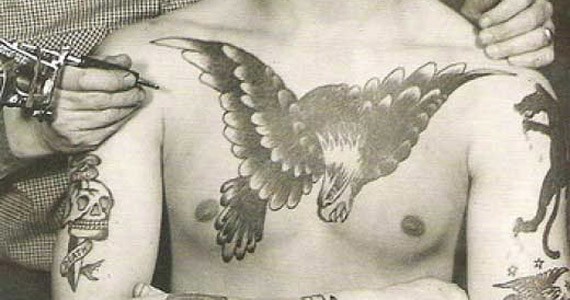It's difficult to pinpoint when tattoos began. The art was happening millennia before the mechanization of the tools occurred. The earliest recorded tattoos date back to 5,000 BC.
Western cultures began to notice these strange markings when explorers "discovered" Polynesia in the South Pacific. In typical fashion, Europeans took the nomadic Polynesians (sometimes by force) to major cities to be displayed for the elite.
But it was sailors who would be the first to adopt tattooing en masse. In 1891, Samuel O'Reilly revolutionized the tattoo industry by taking Thomas Edison's initial autographic printing pen design and repurposed it for tattoos. This cut down the time needed to create a tattoo making it more accessible and reducing the risk of infection.
"We have pictures of sailors absolutely covered in tattoos," says Jennifer Hevenor, curator of an upcoming show at the Maritime Command Museum entitled Sailors Inked. "Tattoos were seen as a right of passage or a badge of honour," she says. "The more you had, the more experience you had at sea."
It's still not widely apparent why sailors in particular took on tattoos with such gusto, but a life at sea does offer some reasoning. With such little living space, tattoos act as mementos or trinkets. On your skin they're pretty hard to lose.
So, where would an average sailor have gone to get a tattoo in Halifax? Starting in the 1920s, one of the most well-known destinations was the North Street Shop, at Barrington Street and Hurd's Lane, a corner demolished for the Scotia Square/Cogswell Interchange development.
Not far from the dockyards and the naval base, the real estate mantra "location, location, location" was one of the reasons for the parlour's success. It was founded by Frank Baldwin, a British sailor who deserted from the Royal Navy after fighting in the Boer Wars and came to Canada during World War I.
"His popularity with the sailors was one of the reasons why his desertion was never brought to the authorities," Hevenor says. "He was doing a military service in another way, increasing morale."
Charlie Snow joined up with Baldwin following the Great War and they worked together through World War II. Demand for their talent was high.
"During the Second World War when they called the victory, these guys didn't even know the victory riots were going on, they were too busy tattooing sailors," says Hevenor.
This period was considered the golden age of traditional naval tattoos for Halifax. Most of these designs had a meaning stemming from Maritime traditions. For example, tall ships would bring crates of pigs and chickens on board so that if the vessel were to sink, these crates would wash ashore providing a source of food for any surviving sailors. Getting tattoos of pigs and chickens was viewed as a good luck charm. Initially the pigs we drawn on the sailor's foot, but over the years rose to the knee, providing the superstitious idiom "pig on the knee, safety at sea, cock on the right, never lose a fight."
Sailors made up the majority of the clientele in local shops. Occasionally, to save face, in the late '60s and '70s tattoo artists would refuse hippies who wanted anti-war imagery.
The North Street Shop was handed down to a man known as Sailor Jerry Swallows. Fascinated with tattoos as a child, he came to the shop frequently and was often shooed away. However, his persistence paid off when he became their errand boy. Charlie Snow noticed his sketches and nurtured his potential, mentoring him in the art. Swallows completed his first tattoo in 1960 and continues to tattoo today, although has since moved to Ontario.
Hevenor is committed to bringing the rich history of naval tattoos into the present. "You can hear the stories from the tattoo artists, and they are one of our best sources at this point," she says. "But at the same time that's really only half of the story. We're using Facebook and other ways to get the sailors' stories out there."

